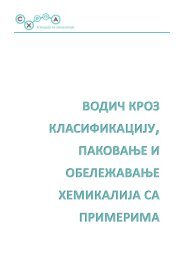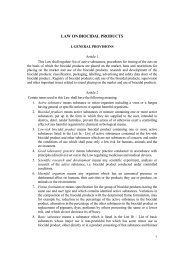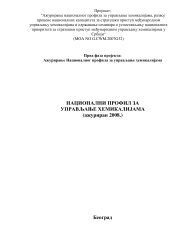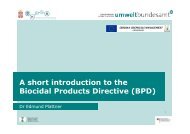GHS (CLP/GHS system) IN PRACTICE - Agencija za hemikalije
GHS (CLP/GHS system) IN PRACTICE - Agencija za hemikalije
GHS (CLP/GHS system) IN PRACTICE - Agencija za hemikalije
You also want an ePaper? Increase the reach of your titles
YUMPU automatically turns print PDFs into web optimized ePapers that Google loves.
The Inventory will serve multiple purposes:• It will be a tool for ha<strong>za</strong>rd communication and a source of basic information on classified substances for thegeneral and professional public of EU as well as non EU states;• It will reveal disagreement on the classification and labelling of the same substance, thus pointing to thepossibility of considering further discussion, evaluation needs or the need for harmonisation of a particularclassification and labelling of a substance;• It will promote transparency and provides companies with a starting point for agreeing on the self classification oftheir substances; and• in EU it will be also an important tool for ha<strong>za</strong>rd communication and risk management, e.g. when EU MemberState Competent Authorities assess the need for potential authorisations and restrictions of ha<strong>za</strong>rdous substancesunder REACH Regulation.4.4.2 What does the Classification & Labelling Inventory contain?The C&L Inventory will contain the identity of the substance, the reason why a classification has not been assignedin cases where a substance has been classified in some but not all ha<strong>za</strong>rd classes or differentiations, specificconcentration limits or M-factors (multiplying factors) and the labelling elements for the substance.European Chemicals Agency (ECHA) will also include the following information:• Whether there is a harmonised classification for a particular entry;• Whether an entry is a joint entry between registrants of the same substance;• Whether it is an agreed entry;• Whether the entry differs from another entry on the Inventory for the same substance.The inventory list will be made public on the ECHA’s website end of summer 2011!4.5 OTHER SOURCESInformation on the ha<strong>za</strong>rdous properties of substances can be sourced in databases which are accessible on theinternet and in scientific journals. One of the most useful source of information is European Chemicals Agency(ECHA) website:http://echa.europa.eu/classification/clp_guidance_en.aspThere you can find quite a number of major available data bases and databanks (some are free of charge, butothers require payment of a fee). A small selection of mentioned sources is following (note that they may notpresent all sources available; any mention of a data source does not imply endorsement of its content):EU information and data sources:• ESIS (European Chemical Substances Information System) on the website of the JRC Consumer ProductsSafety and Quality Unit website:http://ecb.jrc.it/esis/• EFSA (European Food Safety Authority, for active substances of plant protection products):http://www.efsa.europa.eu/EFSA/efsa_locale-1178620753812_ScientificOpinionPublicationReport.htm• Each Member State in the European Union has a national helpdesk. Details can be found at:http://echa.europa.eu/help/nationalhelp_en.asp• The European Commission websites:http://ec.europa.eu/enterprise/reach/ghs/index_en.htmhttp://ec.europa.eu/environment/chemicals/ghs/index_en.htm• Joint Research Centrehttp://ecb.jrc.it/REACH/Non-EU sources:• ECHEM Portal from OECD:16
















